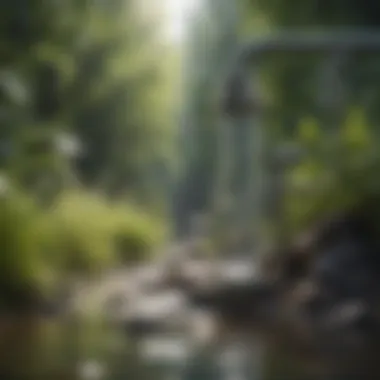Inside a Water Filter: The Science of Clean Water


Nature Topic Overview
Water is a precious resource that we often take for granted. It flows from our taps and fills our glasses, but have you ever wondered how it gets so clean? This article journey takes you inside a water filter to uncover the secrets behind the science of clean water. From simple sedimentation to advanced membrane technologies, each stage of filtration plays a crucial role in providing us with the safe drinking water we need. As you read on, you'll discover not only how filters work but also the importance of protecting our water sources.
Understanding water filtration is more than just a science lesson; it’s about appreciating clean water's vital role in our daily lives. It's essential for our health, supports wildlife, and keeps the environment thriving. Clean water doesn't just appear, and knowing the steps it takes from source to tap helps us understand the broader implications of conservation and sustainability.
Fun Facts and Trivia
- Did you know that there are over 700 million people around the world who lack reliable access to clean water? That's like filling the entire population of North America!
- The Earth is covered by 71% water, but only about 2.5% of it is freshwater suitable for drinking.
- Water can be filtered using materials you might find at home! Coffee filters, sand, and charcoal are common alternatives used in simple DIY filters.
Visual aids and fun activities can help make learning about filtration even more engaging:
- Create a diagram of a water filter with labeled parts.
- Use rocks, sand, and gravel in a clear bottle to create your own mini-filter!
Wildlife Explorations
Clean water is not just important for humans; it's crucial for the creatures that share our planet. Different species rely on clean water to survive, thrive, and reproduce.
- Fish like salmon need clean rivers to spawn. Without clean water, their populations can decline, affecting the entire ecosystem.
- Frogs and tadpoles love calm ponds, which must be free from pollution for them to grow and develop.
To learn more, try these quizzes:
- What animal needs freshwater to reproduce?
- Which plant can thrive in dry areas but needs clean water to grow?
Environmental Awareness
It is essential for everyone to understand the importance of water conservation. Here are a few reasons why clean water should matter to you:
- Health: Safe drinking water prevents sickness and supports our overall well-being.
- Wildlife: Clean water sustains biodiversity; various species depend on it.
- Future Generations: Conserving water today ensures that future generations will have clean water, too.
Here are some practical tips for children on how to protect our precious water:
- Turn off the tap when brushing your teeth.
- Help collect rainwater using a barrel.
- Organize a local cleanup to keep streams and parks free of trash.
DIY Nature Activities
Why not bring what you've learned to life? Here are some hands-on activities to help you explore the world of water filtration at home:
- Build Your Own Water Filter: Gather materials like sand, gravel, and activated charcoal. Layer them in a plastic bottle and pour cloudy water in to see how the filter cleans it.
- Water Conservation Craft: Design a poster about why clean water is important, featuring drawings of animals that need healthy water.
- Nature Walk: Go on a scavenger hunt in your local park and document all the types of water sources like ponds or streams you find.
Engaging with the environment in these practical ways empowers you to make a difference. The knowledge you gain can inspire others and foster a more profound respect for nature.
"Clean water is not just a necessity; it's a gift we must protect for all living things."
As we navigate through these sections, remember that every drop of water counts!
What is a Water Filter?
Water filters play a vital role in providing safe and clean drinking water, a fundamental element for life. Understanding what a water filter is and how it works can demystify the process of ensuring our water is pure. As we dive into this topic, we'll cover essential attributes, benefits, and considerations regarding the importance of water filters in our daily lives.
Definition and Purpose
At its core, a water filter is a device designed to remove impurities from water. These impurities can range from dirt and sediment to harmful bacteria and chemicals. Imagine a sponge soaking up spills—just like a sponge, a water filter works to catch all the nasties, keeping the water you drink much cleaner.
The primary purpose of a water filter is to enhance water quality. Clean water isn’t just a luxury; it’s a necessity for health and well-being. For children and adults alike, drinking dirty water can lead to health issues. Therefore, having a reliable water filtering system in place is crucial for families.
Different Types of Water Filters
Water filters come in several types, each designed to handle different filtration needs and priorities. Let's take a closer look at some common ones:
Activated Carbon Filters
Activated carbon filters are renowned for their ability to adsorb (not absorb!) various contaminants, making them a popular choice. The unique structure of activated carbon gives it a large surface area, which allows it to trap impurities.
One of the main advantages of activated carbon filters is their effectiveness in removing bad tastes and odors from water. Think about it—no one likes to drink water that smells like a swimming pool!
However, it’s important to keep in mind that while these filters can improve taste, they might not eliminate all pathogens, especially if left unchanged for long periods. This makes routine replacement essential to ensure effectiveness.
Reverse Osmosis Systems
Reverse osmosis systems take purification a step further. By pushing water through a semi-permeable membrane, these systems can filter out a staggering variety of contaminants, including salts and heavy metals.
One key characteristic of reverse osmosis is its ability to yield very pure water. This makes it a popular choice for households looking for robust water purity. However, it can also waste a bit of water during the filtering process, which is something to consider for those mindful of water conservation.
Ceramic Filters
Ceramic filters are a fascinating option in water purification. They provide excellent filtration, particularly for bacterial contamination. Made from natural materials, these filters can trap dirt particles and pathogens very effectively.
The beauty of ceramic filters lies in their sustainability. Many are designed to be cleaned and reused multiple times, which can be a win for both the environment and your wallet. On the odd side, though, they can be slower to filter water compared to other systems, which may impact the overall convenience.
In summary, knowing about different types of water filters gives families insights into their choices. Each type has its unique benefits, adapting to various needs and situations. Whether it’s a simple activated carbon filter or an advanced reverse osmosis system, understanding these filters is a step toward making informed decisions for healthier living.
The Role of Water in Nature
Water is often referred to as the essence of life. In this article, we delve into the profound role that water plays not just for us, but across the vast web of nature. Understanding this helps us appreciate the resources we need to protect and conserve.
Water's Importance to Life
Water is fundamental to life as we know it. Think of the last time you had a dry throat; you probably reached for a drink to quench your thirst. That simple act reflects a much larger story. Living organisms, from the tiniest microbes to the largest whales, rely on water to sustain their daily functions.
One of its primary roles is to facilitate biological processes. Here’s a snapshot of its importance:


- Cellular Function: Water is a key component of cells, which are the building blocks of life. Without enough water, cells can’t function properly.
- Nutrient Transport: Water acts as a transport medium, carrying nutrients to cells and waste products away from them. This is crucial for maintaining health and growth.
- Temperature Regulation: Ever notice how sweating cools you down? Water plays an essential role in regulating temperatures in living organisms, maintaining the right environment for biochemical reactions.
As you ponder these points, it's clear that water does more than just fill a glass – it's a lifeline.
Water Cycles and Ecosystems
Moving beyond individual needs, water is a pivotal player in ecosystems. The water cycle is a magnificent process that not only includes precipitation but plays a larger role in sustaining habitats.
Key elements of the water cycle include:
- Evaporation: Water from oceans, lakes, and rivers turns into vapor and rises into the atmosphere.
- Condensation: This water vapor cools down to form clouds, a necessary part of weather systems.
- Precipitation: Eventually, the accumulated water returns to the ground as rain, snow, or hail, replenishing our freshwater sources.
This cycle connects various ecosystems – forests, mountains, rivers – creating habitats for countless species.
Water maintains the balance of life, enabling plants to photosynthesize, animals to thrive, and landscapes to evolve. When ecosystems remain healthy, they support a diversity of life.
Insider’s View: The Structure of a Water Filter
Understanding the structure of a water filter is like peeking under the hood of a car; it reveals how things work behind the scenes to give us clean water. Each component plays a vital role, ensuring that what comes out of the tap is safe to drink. This section will unwrap the main parts of a water filter, emphasizing how they help achieve clear, purified water—something absolutely necessary for health and well-being.
Key Components Explained
Filter Media
Filter media is basically the heart of the water filter. It’s the material that does the heavy lifting in removing contaminants. Common types of filter media include activated carbon, sand, and special membranes.
One of the key characteristics of activated carbon is its huge surface area, which allows it to adsorb impurities effectively. This makes it a favored choice in many filtration systems. The unique feature of filter media like activated carbon is that it can capture both odors and flavors, as well as chemicals that could pose health risks. However, a downside to consider is that they may need replacement after a certain period, to maintain efficiency in filtration.
Housing
Housing holds everything together, kind of like the casing of a television. It protects the inner workings and ensures the filter media stays secure and functional. The key piece of housing is usually made of sturdy plastic or metal, providing durability against wear and tear.
Its main characteristic is that it is often designed to be watertight, preventing water from bypassing the filter media. This tight seal is crucial to ensure that every drop of water passes through the filter, maximizing efficacy. However, a consideration here is that a poorly designed housing can lead to leaks, resulting in wasted water and inefficiency.
Water Inlet and Outlet
The water inlet and outlet are the entry and exit points of the filtration process. When water flows into the filter through the inlet, it faces the filtering action of the media. This is where the magic starts. The key feature of these points is how they regulate water flow; they ensure the right amount of water enters and exits the system.
A well-designed inlet draws water effectively while the outlet allows clean water to flow out smoothly, ready for use. However, if these components aren’t properly maintained, minerals can build up, leading to clogs which may hinder water flow.
How Filtration Works
Understanding how filtration works is the next step, diving into two primary techniques: mechanical and chemical filtration.
Mechanical Filtration
Mechanical filtration serves as the first line of defense in a water filter system. It uses physical barriers to trap particles, such as dirt and sediment, preventing them from contaminating the water supply. This method is highly effective and doesn’t involve any chemicals, making it an excellent starting point for purifying water.
A unique advantage of mechanical filtration is that it can work continuously without needing a lot of maintenance. However, the downside could be limited effectiveness against smaller contaminants like bacteria or viruses, which may not be filtered out by physical means alone.
Chemical Filtration
Chemical filtration takes things a step further. It involves using various substances to remove or neutralize contaminants. Activated carbon filters are famous for this because they bind to a host of chemicals, eliminating them from the water. This allows for a greater range of contaminants to be addressed effectively.
The notable feature of chemical filtration is its ability to improve both taste and safety. Nevertheless, one disadvantage is that this process might lead to chemicals leaching back into the water if the filter is worn out or used beyond its limits.
"Clean water is not just a luxury; it's a necessity for life and health. Understanding the structure of a water filter can help us appreciate how vital it is to ensure safe drinking water every single day."
By investigating these various aspects of water filtration, we gain insight into why each element matters, and how together they contribute to providing clean water.
These explanations create a fundamental understanding of water filters, establishing a well-rounded view that can pave the way for further exploration into filtration processes and technologies.
Mechanisms of Filtration
Water filtration is vital. It helps ensure that the water we drink is clean and safe. Understanding the mechanisms of filtration allows us to appreciate how different techniques work to remove impurities and protect our health. It’s like finding out how a magician pulls a rabbit from a hat—there’s more to it than meets the eye.
Physical Filters: What Are They?
Physical filters work on a simple concept of blocking unwanted material. Think of a sieve you use in the kitchen to separate water from pasta. Just as the sieve lets the water flow through while keeping the noodles behind, physical filters trap larger particles, sand, and sediment in the water.
- How They Work: Water passes through layers of material. It can be made of sand, gravel, or mesh. As water flows, these materials catch solid particles and prevent them from moving along. Think of it as setting up a fine net to catch the fish but letting the water swim freely.
- Benefits: Physical filters are effective at removing large debris. They are often the first line of defense in any water purification system. For example, many home water filters use carbon to not just remove odors but also catch those little bits that can make our water look cloudy.
- Considerations: These filters may need to be checked and cleaned regularly. If they get clogged, water can’t flow through them properly. This is like trying to drink through a straw that’s blocked; it just won’t work.
Biological Filtration: Nature's Way
Biological filtration takes cues from nature itself. This method uses living organisms to break down contaminants—think of it as having tiny helpers cleaning up your backyard. Microorganisms like bacteria play a key role in this process. They feed on organic materials and convert them into harmless substances.
- How It Works: Water passes through a filter medium where these microorganisms reside. As the water moves, bacteria consume harmful pollutants. This interaction cleans the water, making it safe to drink.
- Benefits: One major advantage of biological filtration is that it's natural and can be very effective. It can manage various pollutants without needing many chemicals or extra energy. Plus, it maintains the balance of ecosystems in places like ponds or wetlands.
- Considerations: This type may require a bit more time and patience. It relies on specific conditions to thrive, such as temperature and oxygen levels. In simpler terms, you need to make sure your little helpers have a good environment to work in.
Key Point: The combination of physical and biological filters often leads to cleaner, safer drinking water. Each method brings unique advantages but also has its own set of considerations.
In summary, mechanisms of filtration encompass a broad range of methods that remove impurities from water, using both physical and biological approaches. Understanding these mechanisms helps us make informed choices about water purification and conservation.
Materials Used in Water Filters
Understanding the materials employed in water filtration is crucial. These materials are the unsung heroes of clean water, serving not just as barriers but as conduits of purification. They play an essential role in determining the effectiveness and longevity of the filtering process. With a variety of options available, each material offers unique properties, benefits, and potential drawbacks that need consideration. In this section, we will explore both common and sustainable filtration materials, looking at what makes them vital for achieving clean drinking water.
Common Filtration Materials
Sand
Sand is like the old faithful of water filtration. It has been used for centuries, and it’s still going strong. What’s fascinating about sand is its natural attributes. Small grains of sand act like tiny sieves, trapping dirt and debris when water flows through them. This kind of mechanical filtration is particularly effective for removing larger particles from water, ensuring cleaner output.


One key characteristic of sand that sets it apart is its availability. Sand is plentiful and inexpensive, making it an easy choice for many filtration systems. Furthermore, sand filters are relatively simple to maintain and can last a long time with proper care. However, a downside is that sand may not effectively remove certain dissolved impurities, which might necessitate additional filtration methods down the line.
"Filters using sand show us that sometimes simplicity carries profound efficacy."
Carbon
Activated carbon takes filtration to another level. It’s renowned for its chemical adsorption capabilities; this means it can attract and hold onto contaminants. When water passes through carbon, harmful substances like chlorine, volatile organic compounds, and even certain heavy metals cling to its surface. This feature makes activated carbon a popular choice for many home filtration systems.
A notable advantage of carbon is its ability to improve taste and odor in water. Many people prefer the flavor of water treated with activated carbon compared to untreated water. However, carbon filters need regular replacement to maintain efficiency, as they can become saturated over time. Therefore, keeping an eye on the lifespan of carbon filters is essential for ensuring consistent clean water.
Membrane
Membrane filters, particularly reverse osmosis membranes, are marvels of modern technology. They utilize a semi-permeable barrier to separate impurities from water. When water is forced through these membranes, the process effectively eliminates a wide range of contaminants, including pathogens and dissolved salts.
One key aspect of membranes is their precision. They can filter out incredibly small particles, making them ideal for treating heavily contaminated water sources. However, this advantage comes with some downsides. Membrane systems can be more costly initially and require a steady water pressure to function effectively.
As with any filtration method, sustainable alternatives are becoming more sought-after.
Sustainable Alternatives
In light of environmental concerns, the search for more eco-friendly filtration materials is on the rise. Some sustainable options include:
- Biofilters: Using natural materials like activated sludge or plant fibers. These help in removing impurities while also being biodegradable.
- Clay: Many traditional water purifiers use clay filters, which not only cleanse but are also biodegradable and low-cost.
- Natural Composites: Mixing materials like sand and gravel with innovative natural substances could prove effective while being kinder to the Earth.
Exploring alternative materials can significantly lower the environmental footprint of water filtration systems. The adoption of these materials can lead to not only cleaner water but also a healthier planet.
The Process of Water Purification
The water purification process is like a well-conducted symphony, where each step plays a crucial role in ensuring we have clean water to drink and use. It is critical to understand that water can carry impurities, which may harm our health. Thus, the purification process becomes essential in delivering safe and clean water. This section recounts how the process unfolds through specific stages, emphasizing each step's significance.
Step-by-Step Filtration
This part of the purification journey consists of three integral procedures: Screening, Sedimentation, and Filtration. Each has its unique characteristics and functionalities.
Screening
Screening is the first line of defense in the water purification process. Think of it as a net that catches larger debris before the water moves on. This method involves using sieves or screens to filter out unwanted particles like leaves, twigs, or other floating detritus.
Key Characteristics: The major perk of screening is its effectiveness in removing big stuff. It’s relatively simple and requires minimal equipment, making it easy to implement.
Unique Features: The mesh used in screening can vary in size. A finer mesh catches smaller debris, while a coarser one allows more water to flow through.
Advantages and Disadvantages: Its advantages are clear—it’s quick and efficient. However, its limitation is that it cannot remove small contaminants like bacteria or chemicals, necessitating more steps in the purification process.
Sedimentation
Once the larger particles are out of the way, we move to sedimentation, which can be visualized as letting things settle down. In this stage, water sits undisturbed in a tank, allowing heavier particles to sink to the bottom.
Key Characteristics: Sedimentation is a natural process—the heavier solids fall due to gravity. Because of this, it is often considered an eco-friendly option in water treatment.
Unique Features: This process also forms a sludge layer at the bottom, which can be removed easily afterward, leading to cleaner, clearer water for the next stages.
Advantages and Disadvantages: One major advantage is it effectively lowers the turbidity of water. However, it takes time, as water must remain in the tank for several hours for maximum effectiveness.
Filtration
Filtration is where the magic happens. In this step, water passes through filters made of various materials which trap remaining impurities. It’s the point where water moves from dirty to clean.
Key Characteristics: Filtration uses materials such as sand and activated carbon to capture small particles and chemicals.
Unique Features: The multi-layered approach of filtration allows for the removal of a wide range of contaminants, making it a comprehensive solution for ensuring clean water.
Advantages and Disadvantages: Filtration is effective at getting rid of many unwanted elements such as chlorine or bad smells, but filters do need to be replaced periodically, which can add to the overall cost of maintaining a filtration system.
Post-Filtration Treatments
After water has gone through the filtration process, additional treatments may follow to ensure complete safety and palatability.
Example Treatments:
- Chlorination: Adding chlorine to kill any remaining bacteria.
- UV Treatment: Using ultraviolet light to further purify the water.
- Mineralization: Adding back minerals for taste and health benefits.
Understanding these processes gives us a greater appreciation for the journey water takes from source to tap. By knowing what happens behind the scenes, we can be more mindful about our water usage and its importance.
Environmental Impact of Water Filters
Water filters play a crucial role in maintaining the balance between having access to clean water and minimizing harm to our environment. Understanding the environmental impact of water filters involves looking at how these devices not only purify water but also potentially reduce pollution, conserve resources, and promote sustainability. The importance of this topic cannot be overstated; as we engage with water filters, we must also consider their footprint on our precious ecosystems.
Reducing Plastic Waste
One of the striking advantages of using water filters is their ability to significantly cut down on plastic waste. Every year, millions of plastic bottles fill landfills and oceans, posing threats to wildlife and natural habitats. When individual households adopt water filtration systems, they reduce their reliance on bottled water. This small shift in behavior can have big ramifications. The Environmental Protection Agency (EPA) notes that a single household could save hundreds of plastic bottles a year by filtering tap water instead of purchasing bottled water.
- Benefits of Reducing Plastic Waste:
- Less plastic pollution in the oceans.
- Decrease in landfill waste.
- Reduction in energy consumption related to manufacturing and transporting plastic bottles.
By opting for a filtered water solution, you not only enjoy the taste and purity of water but also contribute to minimizing the ecological footprint associated with plastic production.
Conserving Natural Resources
Water filters also play an essential role in conserving natural resources. Clean water is a limited resource in many areas, and treating water through various methods requires lots of energy and raw materials. Filters allow individuals to utilize their local water supply more efficiently, avoiding the need for extensive water extraction and treatment processes.


Some key points to consider include:
- Local Resource Utilization:
Filtering tap water empowers communities to make use of what is already available in their surroundings, which conserves additional resources. - Energy Savings:
Using water filters typically requires less energy than large-scale water purification plants, allowing for a greener approach to accessing clean water. - Protection of Aquatic Ecosystems:
By lessening the demand for bottled water and enhancing use of local resources, water filters help safeguard habitats that can be disrupted by excessive water extraction.
"Every small drop counts when it comes to preserving our planet. Choosing to filter instead of frequently buying bottled water is a step in the right direction."
These factors highlight the relationship between personal choices and environmental health. By selecting suitable water filters, we can contribute to a sustained and healthy planet while enjoying the benefits of clean water.
Choosing the Right Water Filter
When it comes to ensuring your access to clean drinking water, choosing the right water filter is more crucial than picking a favorite flavor of ice cream. A good water filter doesn't just make your water taste better; it’s also essential for your health and well-being. Making the right choice can mean the difference between safe, refreshing water and a potential breeding ground for unwanted impurities. Let's dive into what you need to keep in mind while selecting a filter.
Factors to Consider
To truly understand how to pick the water filter that suits your needs, there are a few important factors you need to consider. Each factor contributes subtly to the overall effectiveness and efficiency of the filtration process.
Water Quality
Water quality refers to the specific contaminants present in your water supply, which can be quite a mix depending on where you live. Understanding the quality of your local water can guide you to the best filtration solution. For example, if you're dealing with hard water, an activated carbon filter might not be enough; you may need a reverse osmosis system that can thoroughly remove dissolved minerals. The unique feature of knowing your water's quality is that it allows you to tailor your choice to effectively address specific impurities, be it lead, chlorine, or any other undesirable substances. This is beneficial for health, as untreated water may carry health risks.
Local Water Sources
Local water sources can have a major influence on the filtration requirements. If you live in a rural area relying on well water, your immediate needs will be very different compared to someone tapping into a city supply. Local sources often dictate the types of contaminants found in your water, so knowing where your water comes from is key. For instance, city water is typically treated and might have less microbial threat compared to well water. The distinct feature here is understanding that certain filter types work better with specific source water, which translates to a more effective filtration process tailored to your environment.
Usage Needs
Usage needs pertain to how much filtered water you actually require. A small household might do just fine with a pitcher filter, while larger families may need a whole-house system. Identifying your usage is essential for selecting a filter that can adequately meet demands. The flexibility of choosing a small, portable unit versus a robust, station-based system allows families to find something that fits seamlessly into their lifestyles. Knowing your specific usage helps prevent the regret of under or over-investing in filtration options.
Comparing Filter Brands
Once you’ve taken into account the factors discussed, the next step is to compare different filter brands. Each brand offers unique features, certification levels, and pricing. Start by looking for brands that are certified by reputable organizations, as this indicates they meet certain standards for effective filtration. Researching user reviews can also provide insight into the performance and reliability of different filters, helping you make an informed decision.
Remember, quality in filtration often comes at a higher price, but it should not break the bank. Ultimately, choosing the right filter requires some research and consideration, but the benefits of clean, safe water are well worth the effort.
Investing in the right water filter can lead to a healthier lifestyle and contribute to cleaner ecosystems.
For more information on water filtration systems, check out Wikipedia or Britannica.
Future of Water Filtration Technology
The future of water filtration technology holds great promise as it continues to evolve. This section dives into what these advancements might look like, bringing attention to their essential role in ensuring our access to clean and safe drinking water. The world faces mounting challenges regarding water scarcity and pollution, and innovative filtration technologies could be a game-changer in combating these issues. Enhancing our understanding of these technologies helps young readers appreciate their significance in daily life and environmental conservation.
Innovations in Filtration
Innovations in filtration are a big focus right now, addressing some of the critical issues we see with traditional methods. Here are some crucial developments:
- Nanotechnology: This involves manipulating matter at the molecular level to create membranes that can filter out almost every type of contaminant. These filters are not only efficient but also compact, making them suitable for various applications, from household use to industrial settings.
- Smart Filters: Imagine a water filter that can communicate its status! These smart filters use sensors to monitor water quality in real-time, alerting users when it’s time for a change. Such devices are designed to enhance user convenience and ensure optimal performance.
- Solar-Powered Systems: With energy costs soaring, innovative systems that harness solar power to operate filters are becoming increasingly popular. This design is perfect for areas lacking access to electricity, making clean water more accessible to remote communities.
"Innovations in technology pave the way for safer drinking water everywhere."
Emerging Trends in Water Purification
As the eco-conscious movement grows, emerging trends in water purification show how we're moving towards more sustainable practices. Some noteworthy trends to keep an eye on include:
- Home-based Filtration: More people are opting for at-home filtration solutions. These systems are tailored to specific needs, ensuring water sourced from municipal supplies is treated effectively.
- Biodegradable Filters: Traditional filters often contribute to waste. New advances are leading to the development of filters made from biodegradable materials, which break down naturally and reduce environmental impact.
- Community Initiatives: Increasingly, communities are banding together to implement collective filtration systems. This cooperative approach not only promotes environmental stewardship but also fosters a sense of community as people work toward a common goal.
These emerging trends in water purification demonstrate how we can effectively secure clean water while keeping our planet in mind. Each innovation plays a part in shaping a sustainable future where clean water is a norm, rather than a luxury.
Encouraging Water Literacy
Water is not just a basic need; it’s a resource that connects everyone to nature and to each other. Understanding the importance of water and how to keep it clean offers children an opportunity to appreciate their environment and contribute positively to it. When we consider the concept of water literacy, we essentially look at how well children comprehend water's role in their lives and the ecosystem at large. Educating kids on this subject is vital for fostering responsible behavior towards water conservation and pollution prevention.
Through focused education on water, children can grasp fundamental concepts such as the water cycle, sources of water pollution, and the significance of using water filters. This knowledge helps cultivate a sense of responsibility regarding their personal water usage and its wider implications.
Further, teaching kids about water also brings in other essential topics, like health and hygiene. Many don’t realize that not all water is safe to drink. By knowing how to identify clean water and the processes that support its cleanliness, children can make informed choices that affect their health and well-being.
There are numerous benefits to fostering water literacy:
- Critical Thinking: Kids learn to analyze problems related to water use and conservation.
- Community Engagement: Understanding local water issues can encourage children to take part in community clean-up events or conservation efforts.
- Long-term Responsibility: Being water literate establishes a foundation for future generations to prioritize sustainability.
"The greatest threat to our planet is the belief that someone else will save it." – Robert Swan
Equipping children with knowledge about water can empower them to be proactive members of their communities and that is crucial as we collectively face water-related challenges.
Educational Resources for Kids
When it comes to learning about water in an engaging way, there are myriad resources suitable for children. Below are some fun and interactive tools to guide young minds:
- Books and Storytelling:
- Games and Apps:
- Online Videos:
- Hands-On Experiments:
- The Magic School Bus: Waterworks by Joanna Cole
- A Drop in the Ocean by Jennifer Ward
- Water Heroes: This app teaches children about conserving water through various challenges.
- Water Cycle Challenge: A fun way to engage kids with quizzes about the water cycle.
- YouTube has many education channels that focus on science, including videos on how water is filtered and the importance of clean water.
- PBS Kids often has animations that explain water-related concepts simply and engagingly.
- Conducting water filtration projects at home helps children grasp the practical aspects of a water filter while fostering creativity. For example, creating a simple filter using sand, gravel, and activated charcoal can illustrate how particles are trapped to clean water.
These resources not only make learning engaging but also enhance the understanding of why clean water is essential.
Fun Facts About Water
Engaging kids with fun facts is a fantastic way to spark their interest in water conservation. Here are some tidbits that might surprise them:
- Water in Our Body: The human body is approximately 60% water! It plays a vital role in keeping us healthy.
- Dinosaur Connection: Some of the water we drink may have existed during the age of dinosaurs, recycled through the earth's water cycle.
- Earth's Blue Planet: About 71% of our planet’s surface is covered in water, yet only a tiny fraction is drinkable.
- Water Cycle Magic: Water can evaporate into the atmosphere, travel long distances, and then fall back to the earth as rain or snow, demonstrating nature's recycling ability.
- Fresh Water Scarcity: Only about 2.5% of the earth's water is fresh; the rest is salty ocean water.
These intriguing facts can act as conversation starters, allowing parents, teachers, and kids to discuss the significance of water and the importance of keeping it clean. Encouraging a fascination with water not just teaches children, but it nourishes a soulful connection between them and their environment.







